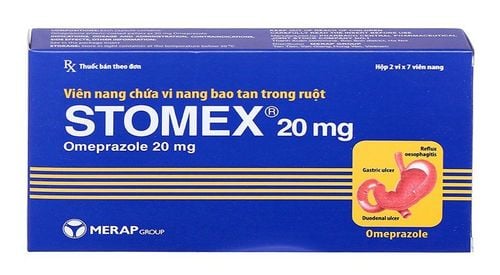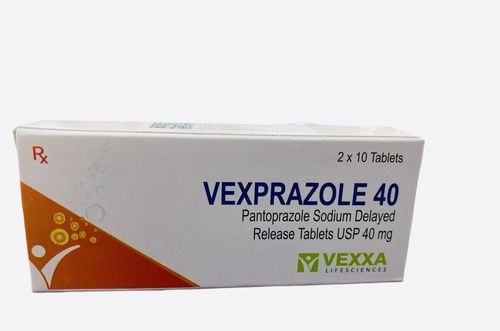This is an automatically translated article.
Medinpacol belongs to the group of gastrointestinal drugs, indicated for the treatment of gastric and esophageal ulcers. Let's find out what Medinpacol is used in a few articles below.
1. What is Medinpacol?
Medinpacol medicine contains Omeprazole 20mg and other excipients just enough for 1 tablet. The drug is prepared in the form of hard capsules, the box includes 2 blisters, each blister has 10 tablets.
2. What are the uses of Medinpacol?
Medinpacol is indicated for the treatment of the following cases:
Gastroesophageal reflux disease (GERD). Treatment of gastrointestinal ulcers. Zollinger-Ellison syndrome. In addition, Medinpacol is contraindicated in the following cases:
The patient is allergic to the active ingredient Omeprazol, Benzimidazol derivatives and other excipients in the composition of the drug. Currently being treated with the drug Nelfinavir.
3. Dosage and how to take Medinpacol
3.1. How to take Medinpacol Medinpacol medicine is prepared in the form of hard capsules, taken orally. The drug should be taken in the morning, preferably on an empty stomach. Patients should take the drug with water, do not chew or crush Medinpacol tablets before taking.
For patients with difficulty swallowing : The medicine can be opened into water or slightly acidic fruit juice (juice, apple juice) and should be taken immediately (or within 30 minutes). Stir well to dissolve the drug completely before drinking, rinse with water and drink this rinse.
Do not take Medinpacol with milk or water containing carbonate.
3.2. Dosage The following is the recommended dose of Medinpacol:
Relieve acid indigestion symptoms:
Use at a dose of 10mg or 20mg/day, continuously for 2-4 weeks. Treatment of gastroesophageal reflux:
The usual dose is 20mg x 1 time / day, used continuously for 4 weeks, can continue for another 4 - 8 weeks if the disease is not completely cured. Patients with persistent esophagitis can take 40mg/day. The maintenance dose when recovering from esophagitis is 20mg once a day and for acid reflux is 10mg/day. Treatment of peptic ulcers:
Use at a dose of 20mg/day, or 40mg/day in severe cases. Continuous treatment for 4 weeks for patients with duodenal ulcer and 8 weeks for patients with gastric ulcer. Maintenance dose 10 - 20mg x 1 time / day. Treatment of Helicobacter pylori in peptic ulcers: Medinpacol can be combined with other antibiotics in specific dual or triple therapy as follows:
Dual therapy: Use at a dose of 20mg x 2 times/day, use continuously for 2 weeks. Triple therapy: Use at a dose of 20mg x 2 times/day, continuously for 1 week. Patients with peptic ulcers due to non-steroidal anti-inflammatory drugs:
At a dose of 20 mg/day, this dose is also used for prevention in patients with a history of gastrointestinal injury requiring anti-inflammatory drugs. non-steroid. Zollinger - Ellison syndrome:
Use at a dose of 60mg x 1 time / day, adjust the dose as necessary. The majority of patients are effectively controlled at doses ranging from 20 to 120 mg/day, but doses up to 120 mg 3 times/day can be used. With a daily dose of more than 80mg, the drug should be divided into 2 oral doses. Prophylaxis of acid aspiration during anesthesia:
40mg the night before surgery and another 40mg 2-6 hours before surgery. Patients with impaired renal function and people over 65 years old:
Use the usual adult dose. Patients with liver failure:
Use at a dose of 10-20mg/day. Note: The above dosage is only the recommended dosage. The treating doctor will adjust the dose of the drug in accordance with the condition of each patient to ensure safety and effectiveness.
4. Medinpacol side effects
Doctors always consider between the benefits that Medinpacol brings to the patient and the possible risk of side effects to prescribe the appropriate medication.
Medinpacol is generally well tolerated, side effects are usually mild and transient, usually resolve when treatment is stopped.
Some possible side effects when taking the drug include:
Common:
Headache, somnolence, dizziness, nausea, vomiting, abdominal distention, diarrhea and constipation. Uncommon:
Insomnia, confusion, fatigue, urticaria, pruritus and rash. Rare:
Sweating, edema of the limbs, hypersensitivity including angioedema, fever and anaphylaxis. Leukopenia, decreased glomerular dose, decreased total blood cells, gynecomastia in men, gastritis, candidiasis, dry mouth, hepatitis, jaundice, arthralgia and myalgia. If you experience these symptoms, you need to stop using Medinpacol and notify your doctor for appropriate treatment.
5. Medinpacol drug interactions
It is necessary to list drugs such as prescription drugs, over-the-counter drugs, functional foods, herbs, etc. that the patient is using so that the doctor knows and advises in order to limit the interaction reactions when using the combination. drugs during treatment.
6. Notes when taking Medinpacol
Some notes when patients taking Medinpacol include:In case the patient has symptoms such as a lot of weight loss, prolonged vomiting, difficulty swallowing, vomiting blood or black stools, suspected or ongoing stomach ulcer , the possibility of malignancy should be excluded because treatment may alleviate symptoms and delay diagnosis. A combination of proton pump inhibitors and Atazanavir is not recommended for patients. If this combination is deemed necessary, the patient should be closely monitored for clinical manifestations in combination with increasing the dose of Atazanavir to 400 mg and 100 mg of Ritonavir, the dose of Medinpacol should not be increased. Medinpacol may decrease the absorption of vitamin B12 by reducing or lacking hydrochloric acid. Therefore, this factor should be considered in patients with reduced body stores or at risk of impaired absorption of vitamin B12 with long-term therapy. Only use Medinpacol for pregnant women unless absolutely necessary and specifically prescribed by the treating doctor. Note the subjects driving vehicles and machines about the possibility of falling asleep during drug administration. In the elderly, caution should be exercised when high doses of Medinpacol are used over a long period of time c, there may be a slight increase in the risk of hip, wrist and spine fractures. The risk of severe hypomagnesaemia may occur with treatment with Medinpacol for at least 3 months and in most cases for about 1 year. The patient needs to take a magnesium supplement and stop taking it. Above is information about uses, dosage and precautions when using Medinpacol. To ensure safety for your health and maximize the effectiveness of your treatment, you need to take Medinpacol exactly as directed by your doctor. Note, Medinpacol is a prescription drug, patients absolutely must not use it without a prescription from a specialist.













